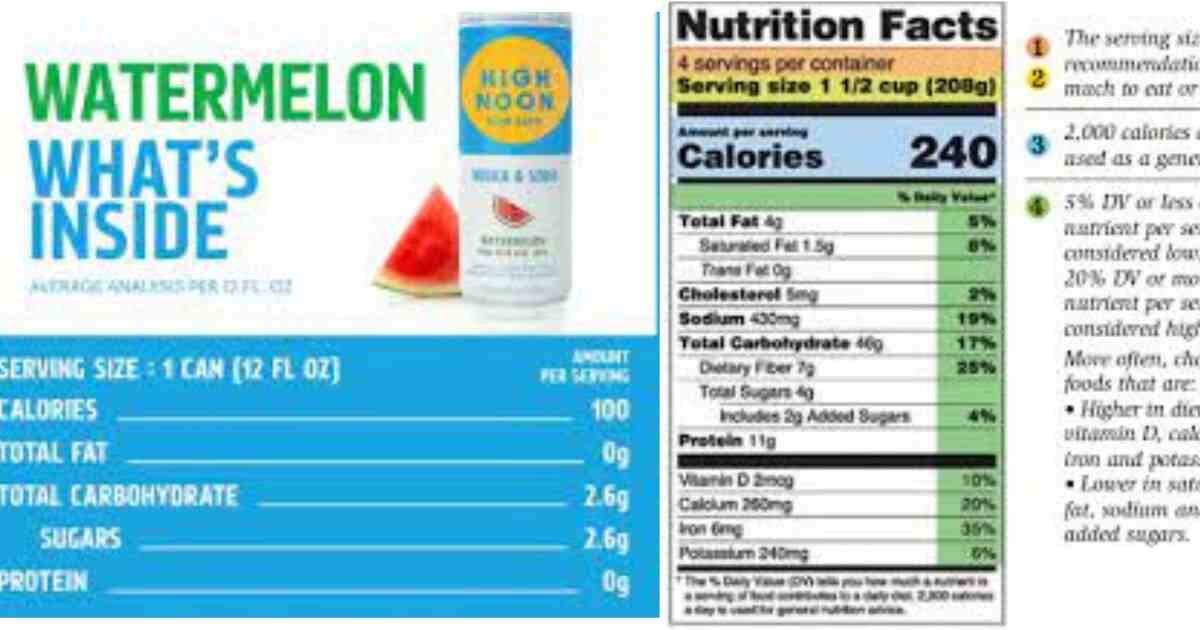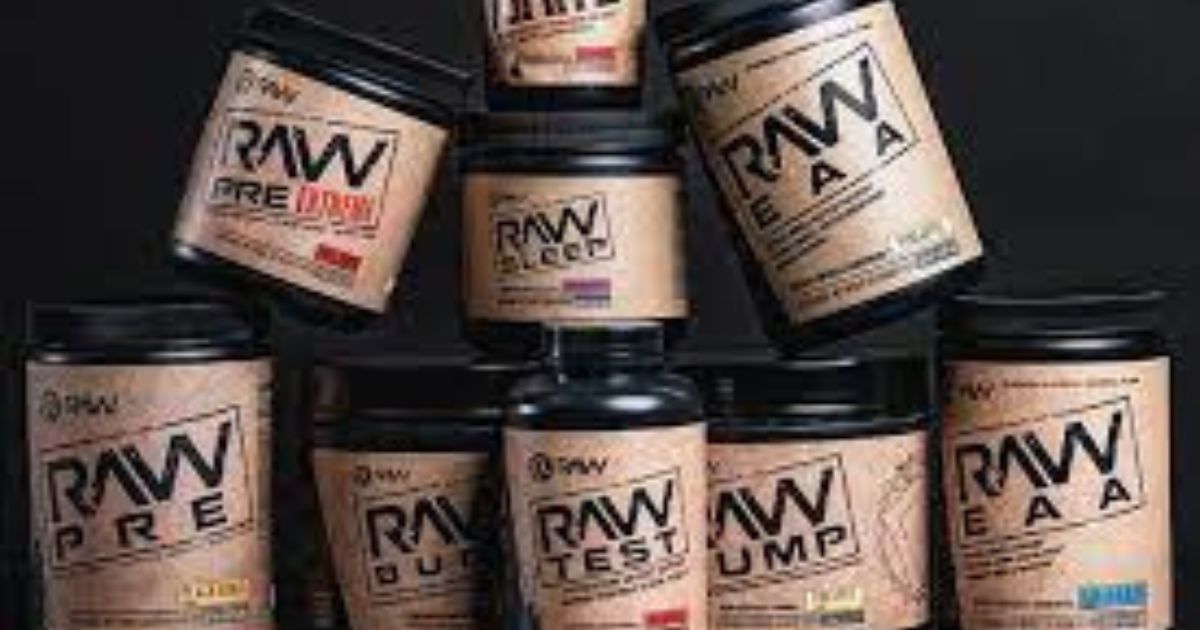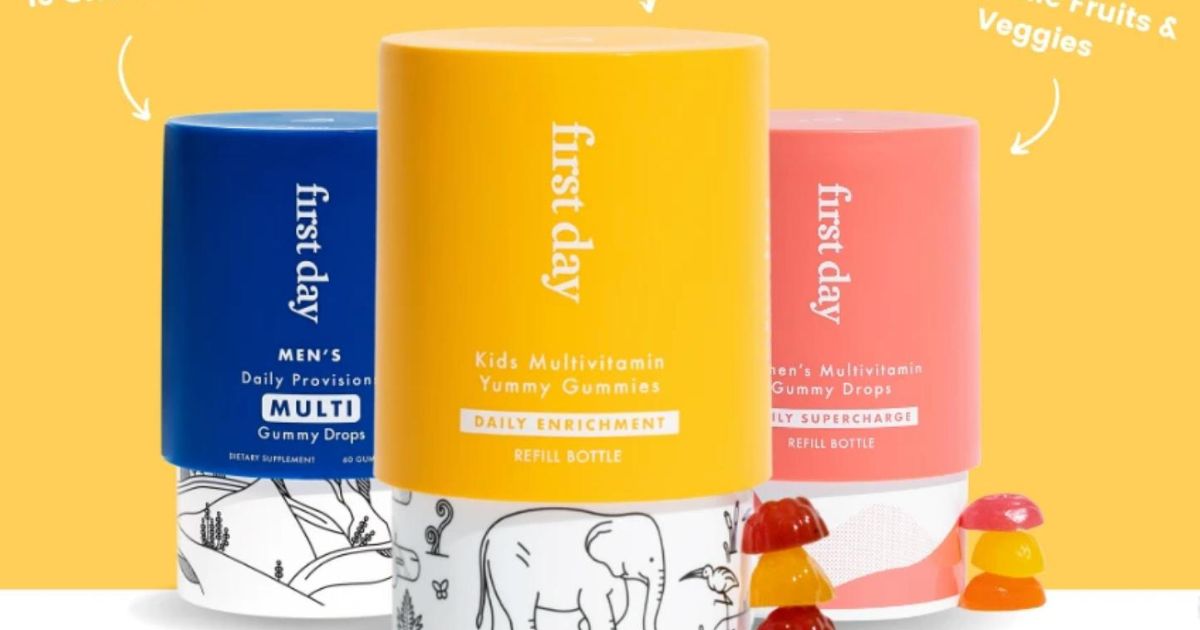The high noon nutrition label provides information on the nutritional contents of the product. This includes details on the serving size, calories, and ingredients.
High noon is a popular brand known for its delicious, gluten-free, and vegan-friendly snacks. Their nutrition label is designed to give consumers a complete picture of what they are consuming. It includes information such as the serving size, number of calories, and details on the ingredients used.
The label also provides details on the percentage of daily values for essential nutrients such as fat, sodium, and protein. This makes it easier for consumers to make informed choices based on their dietary requirements. With the high noon nutrition label, consumers can enjoy their snack without compromising on their health.

Understanding High Noon Nutrition Label
The Significance Of Nutrition Labels
Nutrition labels are a vital tool for anyone who wants to make informed choices about what they eat. The labels give you important information about the food you’re consuming, which can help you to make healthier choices and maintain a balanced diet.
Here are some of the key reasons why nutrition labels are significant:
- They tell you the serving size, so you can understand how much of the food you’re eating.
- They inform you about the calorie content, so you can keep track of your daily calorie intake.
- They inform you about nutrients in the food, such as fat, protein, and carbohydrates.
- They tell you about the daily values for each nutrient, which can help you to determine the percentage of your daily intake that the food provides.
Breaking Down The Components Of High Noon Nutrition Label
Nutrition labels are made up of several components that provide valuable information about a food product. Here’s how you can break down the components:
- The serving size tells you how much of the food is considered one serving. This allows you to understand how much of the food you’re eating.
- The calorie count is the number of calories in one serving of the food. This can help you to manage your daily calorie intake.
- The list of nutrients provides information about the levels of different ingredients in the food, such as fat, protein, and carbohydrates.
- The daily value percentages offer a quick and easy way to understand the nutrient content of the food.
Understanding Serving Sizes
Serving sizes play a crucial role in nutrition labels and can help you to understand how much of a food you should consume. Here are some key points about serving sizes:
- Serving sizes are standardized to make it easier for consumers to compare different foods and understand how much they should eat.
- The serving size is based on the amount of food that most people would consume in one sitting.
- The serving size can be found at the top of the nutrition label.
Making Sense Of Daily Values
Daily values help you determine how much of a nutrient you’re getting from a food in relation to your daily intake. Here are some things to consider when reading daily values:
- Daily values are based on a 2,000 calorie diet, which is an average daily intake for adults.
- Daily values are given as a percentage of the recommended daily intake for each nutrient.
- The higher the percentage, the greater the amount of that nutrient is in one serving of food.
Differentiating Between Different Types Of Fats
Fats are essential for a healthy diet, but some types are better for you than others. Here are the different types of fats you might see on nutrition labels:
- Saturated fats can increase your cholesterol and your risk of heart disease, and should be limited in your diet.
- Trans fats are the most unhealthy type of fat, and should be avoided entirely.
- Unsaturated fats are healthier fats that can improve cholesterol levels and lower your risk of heart disease.
Analyzing The Sugar Content
Sugar can be a sneaky ingredient in many foods, and it’s important to keep track of your intake. Here are some things to consider when analyzing the sugar content on a nutrition label:
- The sugar content refers to both natural and added sugars.
- Ingredients that end in “ose” (such as glucose and fructose) are added sugars.
- The american heart association recommends that women consume no more than 6 teaspoons (or 24 grams) of added sugars per day, and men consume no more than 9 teaspoons (or 36 grams) per day.
How High Noon Nutrition Label Affect Your Health
The Impact Of Nutrition Labels On Your Health
Nutrition labels are a vital tool for informing consumers about the content of packaged foods. They primarily display the number of calories, fat, cholesterol, carbohydrates, sugars, and protein in each serving. Reading and understanding nutrition labels accurately can significantly impact your overall health.
Here are some points to consider:
- Take note of serving sizes: Serving sizes on nutrition labels influence all the nutritional information indicated on the label. It is imperative to determine whether a serving size is consistent with your diet plan’s needs.
- Watch out for added sugars: Foods with high amounts of added sugar may lead to various health concerns, including a higher risk of heart disease, obesity, and diabetes.
- Check the percentage of daily value (%dv): The dv shows the recommended amounts of vitamins and minerals per day to maintain good health. Percentage dv helps you understand how much each serving size contributes to your entire daily needs.
The Correlation Between Nutrition And Chronic Diseases
Chronic diseases, such as diabetes, heart disease, and obesity, are generally a result of an unhealthy lifestyle and suboptimal nutrition. Nutrition labels play an essential role in helping people make informed choices about what they eat, thereby reducing the risk of chronic diseases.
Below are some factors to note:
- Excessive sugar intake: Consuming foods with high amounts of sugar increases the risk of diabetes and obesity.
- Increased saturated fat intake: Regular consumption of food rich in saturated fats can result in increased cholesterol levels, leading to a higher risk of heart disease.
- Lack of essential nutrients: Poor diets are often characterized by a scarcity of certain vitamins and minerals, which can lead to weakened immune systems, health deficiencies, and chronic diseases.
Reducing The Risk Of Chronic Diseases Through Improving Nutrition
It is crucial to maintain a healthy diet to reduce the risk of chronic diseases, and this can be achieved by improving nutrition. With a solid understanding of nutrition labels and food content, you can make informed decisions about the food you eat.
Here are some tips to reduce your risk of chronic diseases:
- Limit your sugar intake: Avoid consuming foods high in sugar, such as sugary beverages, processed foods and snacks, sweets, and cakes. Instead, opt for whole foods that contain natural sugars, such as fruits.
- Choose lean protein: Meat and meat products with high levels of saturated fat can adversely affect heart health. Consider alternatives such as fish, legumes, chickpeas, tofu or lean beef or poultry.
- Include more fruits and vegetables in your diet: Fruits and vegetables offer essential nutrients that reduce the risk of chronic diseases. They are also high in fibre and low in calories, making them a healthy and filling addition to any meal.
The Significance Of Portion Control
Portion control is the final critical piece of maintaining overall health, specifically for reducing the risk of chronic diseases and obesity. One of the main benefits of nutrition labels is that they can help inform portion control by noting serving sizes and nutrients included in those serving sizes.
It is essential to understand the significance of portion control to maintain good health. Here are some points to note:
- Controlling caloric intake: Overeating can lead to consuming an excess of calories and increasing your risk of obesity and associated diseases.
- Preventing nutrient deficiencies or excesses: Portion control helps ensure that you get the right balance of nutrients from different food groups.
- Enhancing overall well-being: Maintaining portion control can boost well-being and contribute to weight loss or maintenance, good digestion and metabolic rates.
Common Misconceptions About High Noon Nutrition Label
Dispelling Common Myths About Nutrition Labels
Understanding nutrition labels is critical to making informed decisions about our diet. However, there are common misconceptions about them. We’ll clear up some of these myths and help you make better choices.
- Myth: Low-fat is always better. Low-fat products may still be high in sugar, salt, and harmful additives. Always look at the label to ensure the product is healthy.
- Myth: The fewer calories, the better. The truth is, we need calories to fuel our bodies. Consuming too few calories can lead to malnutrition and poor health. Aim for a balanced diet with plenty of nutrients.
- Myth: All nutrition labels are the same. Manufacturers may use different serving sizes and measurements, which can make comparisons difficult. Always pay attention to serving sizes and compare like for like.
- Myth: Nutrition labels always tell the truth. Manufacturers may use misleading labels, such as “natural” or “organic.” Always look beyond the front label and read the full ingredient list to verify.
The Truth About “Low-Fat” And “Reduced-Sugar” Products
Manufacturers often market products with “low-fat” and “reduced-sugar” labels as healthier options. However, it’s essential to understand what these labels mean and what they don’t.
- Low-fat products: Low-fat products often contain more sugar and harmful additives to make up for the lack of fat. These additives may lead to more processed and less healthy food choices.
- Reduced-sugar products: Reduced-sugar products may contain harmful artificial sweeteners to make up for the lack of sugar, which can have long-term health consequences. Always look beyond the label to ensure that the product is healthy and balanced.
Overcoming Misconceptions About Preservatives And Additives
Many people avoid food additives and preservatives because of the misconception that they are harmful. However, certain preservatives are essential to maintain food quality and safety, and not all additives are harmful.
- Preservatives: Preservatives, such as vitamin c and vitamin e, can improve the quality of food and prevent spoilage. Look for natural preservatives and avoid products with artificial preservatives.
- Additives: Not all additives are harmful, and some are essential for food quality and safety. For example, emulsifiers keep oil and water mixed together, preventing the separation of sauces. Always research the additives listed on the label to ensure that they are safe and healthy.
By dispelling these myths and understanding the truth about nutrition labels, you can make healthy and informed food choices. Remember to always read the full ingredient list, pay attention to serving sizes, and ensure that the product is balanced and healthy.
Decoding Hidden Ingredients On High Noon Nutrition Label
Uncovering Hidden Ingredients
The ingredient list on a nutrition label can be overwhelming and confusing, especially with the number of hidden ingredients present. Here are some points to consider when decoding hidden ingredients on nutrition labels:
- Manufacturers can disguise unhealthy ingredients with unclear names such as “natural flavors” and “spices.”. It’s a tactic to make products look healthier and avoid scrutiny.
- Use the fda’s official list of ingredients as a reference to understand what exactly is labeled as “natural flavoring” or other broad ingredients.
- Check the ingredient list for any unwanted additives, such as monosodium glutamate (msg), hydrogenated oils, and high-fructose corn syrup.
The Importance Of Paying Attention To The Ingredient List
Reading the ingredient list on a nutrition label is essential as it helps you understand what you’re consuming and the overall quality of the product. Here are some points to consider when doing so:
- A product’s ingredients are listed in order of quantity, with the major ingredients first. Be wary of products that have sugar, corn syrup, or other unhealthy additives listed first.
- Products marketed towards healthy eating, such as granola or protein bars, could contain as many calories and sugar as some candy bars. It’s essential to check the label beforehand.
- According to research, more natural ingredients, such as fruits and vegetables, are always beneficial for our health. The more we rely on whole foods to fuel our bodies, the better we feel.
Identifying High-Fructose Corn Syrup And Other Hidden Sugars
The amount of sugar in our daily diet is concerning and can lead to various health problems such as obesity and type 2 diabetes. Here are some points to consider when identifying high-fructose corn syrup and other hidden sugars:
- Products marketed as “low-fat” often contain more sugar than fat, leading to more calorie intake.
- The american heart association recommends that women should only consume a maximum of 6 teaspoons, whereas men can consume up to 9 teaspoons of added sugar per day.
- Look for hidden sugars on the ingredient list, such as fructose, dextrose, lactose, and corn syrup, among others.
- To avoid hidden sugars, decrease processed foods, and opt for natural sweeteners like raw honey, maple syrup, or fruits.
By understanding how to decode hidden ingredients on nutrition labels, paying attention to the ingredient list, and identifying high-fructose corn syrup and other hidden sugars, we can make healthier and more intelligent food choices.
How To Use Nutrition Labels To Make Healthier Choices
High noon nutrition label: how to use nutrition labels to make healthier choices
Eating healthy is essential, but it can be challenging to make the right choices when you’re surrounded by tempting foods. Fortunately, the nutrition label is here to help. This tiny box contains a wealth of information that can assist you in making healthier meal choices.
Keep reading to learn how to use nutrition labels to make better choices for your health.
Making Healthier Choices Using Nutrition Labels
Here are some crucial tips for using nutrition labels to make healthier eating decisions:
- Look for foods that are lower in fat, saturated fat, and trans fat. Try to limit your total fat intake to 20-35% of your total daily calories.
- Choose items with less sodium. Daily sodium intake should be under 2,300 milligrams.
- Choose foods with more fiber. A high-fiber diet helps to reduce the risk of heart disease, type 2 diabetes, and other health issues.
- Opt for foods with more vitamins and minerals such as vitamin d, calcium, and potassium.
- Always check the serving size. Some packages contain more than one serving, which means you will need to adjust the nutritional information accordingly.
Tips For Grocery Shopping
Grocery shopping can be overwhelming when you’re trying to make healthier choices. Here are some tips to make the process smoother and less stressful:
- Plan your meals before you go grocery shopping. This will help you shop for the ingredients you need for healthy meals.
- Always make a grocery list before you go shopping. This will save you time and help you stick to your healthy eating plan.
- Stick to the perimeter of the store where the fresh produce and healthier options tend to be.
- Avoid buying unhealthy foods that are not on your list.
- Don’t shop when you’re hungry. You are more likely to purchase junk food when you’re hungry.
Strategies For Meal Planning And Preparation
Meal planning is an excellent way to ensure you eat healthily throughout the week. Here are some strategies for successful meal planning and preparation:
- Plan your meals ahead of time and make a grocery list accordingly.
- Cook larger portions and freeze them for later, so you always have a healthy meal ready to eat.
- Meal prep on the weekends and portion your meals into grab-and-go containers for quick meals during the week.
- Use healthy cooking methods, such as grilling or baking, instead of frying.
- Experiment with new healthy recipes to add variety to your meals.
How To Read Between The Lines Of Confusing Food Labels
Nutrition labels can be confusing, especially when food manufacturers use misleading terms like “natural” or “low-fat. ” Here are some tips to help you understand what you’re really eating:
- Look for the ingredient list. The first ingredient listed is what the product mainly comprises. Make sure it’s a whole food and not something like high-fructose corn syrup.
- Be cautious of food that is labeled as low-fat or reduced-fat, as these products might contain more sugar and unhealthy ingredients.
- Don’t fall for buzzwords such as “organic” or “natural.” These terms don’t necessarily mean the food is healthy.
- Avoid foods with preservatives or chemicals that you can’t even pronounce, as these are typically unhealthy additives.
Making healthier food choices can be a daunting task, but it doesn’t have to be. By using nutrition labels to your advantage, grocery shopping smartly, meal planning and preparation, you can enjoy delicious and nutritious meals with ease. Use these tips to help you make the most of nutrition labels and give your body the nutrients it needs to stay healthy.
Frequently Asked Questions On High Noon Nutrition Label
What Is High Noon Nutrition Label?
High noon nutrition label is a nutritional label that displays the amount of nutrients in a certain food or drink product. It helps consumers make informed decisions about their dietary choices.
What Does A High Noon Nutrition Label Include?
A high noon nutrition label includes information about serving size, calories, total fat, saturated fat, trans fat, cholesterol, sodium, total carbohydrates, dietary fiber, total sugars, added sugars, protein, and vitamins or minerals.
How Do I Read A High Noon Nutrition Label?
To read a high noon nutrition label, start by checking the serving size and number of servings per container, then check the calories and the different nutrients listed. Pay attention to the percent daily values, as they show how much of each nutrient is in a single serving compared to the recommended daily amount.
Why Is A High Noon Nutrition Label Important?
A high noon nutrition label is important because it helps consumers make informed decisions about the food and drinks they consume. It helps individuals maintain a healthy diet and prevent chronic diseases.
Is High Noon Nutrition Label Mandatory?
Yes, the high noon nutrition label is mandatory on packaged food and drink products. The fda requires all packaged food and drink products to have a nutrition facts label that meets certain requirements to help consumers make informed decisions about the food and drink they purchase.
Conclusion
After taking a closer look at the high noon nutrition label, it is evident that the drink is a healthy choice for those who are looking for a tasty and refreshing way to stay hydrated. The high electrolyte content ensures proper hydration, while the absence of added sugars and artificial ingredients makes it a great option for those who are health-conscious.
Additionally, the fact that it contains only 5 calories per serving makes it an excellent choice for those who want to keep their calorie intake in check. Overall, drinking high noon is a healthy and tasty way to stay hydrated, particularly during hot summer months, when we are most at risk of dehydration.
So, whether you are headed to the beach or just want to quench your thirst, go for high noon and enjoy the delicious taste and health benefits it offers.




